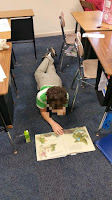Yep, that's right! The Owl Spot is on SALE for Cyber Monday and Tuesday. If you're like me, you're sitting on your couch, DREADING going back to school tomorrow. Thanksgiving break was way too short, and Winter Break seems too far away.
I have the solution for you, though. I just finished a new Christmas product that I'm quite sure will help you get through these next couple weeks, all while keeping your students occupied and engaged while still learning.
(drum role....) CHRISTMAS TRADITIONS READING PASSAGES AND ACTIVITIES
Click the image link for a preview...
I loved researching about these fun holiday traditions (hanging stockings around the fireplace, sending Christmas cards, finding the "Christmas Pickle"). I know your students (and mine) will love reading about them, too.
Here's my SPECIAL gift to you... if you purchase my new Christmas Traditions during the Cyber Sale (reg. $5 - take 25% off), you can receive a new game (that's not even in my store yet) called Grammar Races for FREE!
Just email me your name, email address, and your order number. I will email you the game as soon as I'm able to finish it. I'll have a primary version and an intermediate grades version (you'll have to let me know which one you want). This game will be available in my store after the New Year.
Sending me your email will also give you access to 10 Free ELA and MATH Games to use in your classroom. All of these products will make these last weeks until Winter break bearable!
Here's a few other newer products that would be a great snag during the Cyber Sale...
2. Aesop's Fables for Big Kids Readers' Theater Bundle
3. Emoji Multiplication Mystery Puzzles
4. The Spider and the Fly Poetry Analysis Pack
5. Math Mystery Pictures
Primary
Intermediate Grades

Well, I'm going to go load up my cart! Make sure grab these great deals (and freebies!) during the sale! I'll chat with you soon about writing workshop and other great classroom stories!
Happy Teaching! - Martha from "The Owl Spot"
www.teacherspayteachers.com/store/the-owl-spot




































